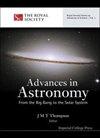A Numerical Approach to Study Ablation of Large Bolides: Application to Chelyabinsk
IF 1.2
4区 物理与天体物理
Q3 ASTRONOMY & ASTROPHYSICS
引用次数: 4
Abstract
In this study, we investigate the ablation properties of bolides capable of producing meteorites. The casual dashcam recordings from many locations of the Chelyabinsk superbolide associated with the atmospheric entry of an 18 m in diameter near-Earth object (NEO) have provided an excellent opportunity to reconstruct its atmospheric trajectory, deceleration, and heliocentric orbit. In this study, we focus on the study of the ablation properties of the Chelyabinsk bolide on the basis of its deceleration and fragmentation. We explore whether meteoroids exhibiting abrupt fragmentation can be studied by analyzing segments of the trajectory that do not include a disruption episode. We apply that approach to the lower part of the trajectory of the Chelyabinsk bolide to demonstrate that the obtained parameters are consistent. To do that, we implemented a numerical (Runge–Kutta) method appropriate for deriving the ablation properties of bolides based on observations. The method was successfully tested with the cases previously published in the literature. Our model yields fits that agree with observations reasonably well. It also produces a good fit to the main observed characteristics of Chelyabinsk superbolide and provides its averaged ablation coefficient σ = 0.034 s2 km−2. Our study also explores the main implications for impact hazard, concluding that tens of meters in diameter NEOs encountering the Earth in grazing trajectories and exhibiting low geocentric velocities are penetrating deeper into the atmosphere than previously thought and, as such, are capable of producing meteorites and even damage on the ground.研究大型碳化物烧蚀的数值方法:在车里雅宾斯克的应用
在这项研究中,我们研究了能够产生陨石的卤化物的烧蚀特性。来自车里雅宾斯克超级固体多个地点的随机行车记录仪记录与18 直径为m的近地天体(NEO)为重建其大气层轨迹、减速和日心轨道提供了极好的机会。在这项研究中,我们重点研究了车里雅宾斯克代谢产物在减速和碎裂的基础上的烧蚀特性。我们探索是否可以通过分析不包括中断事件的轨迹片段来研究表现出突然碎裂的流星体。我们将该方法应用于车里雅宾斯克bolide轨迹的下部,以证明所获得的参数是一致的。为此,我们实现了一种数值(龙格-库塔)方法,该方法适用于根据观测结果推导玻利维亚的烧蚀特性。该方法已成功地与文献中先前发表的案例进行了测试。我们的模型得出的拟合结果与观测结果相当吻合。它还很好地拟合了车里雅宾斯克超级固体的主要观测特征,并提供了其平均烧蚀系数σ = 0.034 s2 km−2。我们的研究还探讨了撞击危险的主要影响,得出的结论是,直径数十米的近地天体以掠掠轨迹与地球相遇,并表现出较低的地心速度,它们比以前想象的更深入大气层,因此能够在地面上产生陨石,甚至造成破坏。
本文章由计算机程序翻译,如有差异,请以英文原文为准。
求助全文
约1分钟内获得全文
求助全文
来源期刊

Advances in Astronomy
ASTRONOMY & ASTROPHYSICS-
CiteScore
2.70
自引率
7.10%
发文量
10
审稿时长
22 weeks
期刊介绍:
Advances in Astronomy publishes articles in all areas of astronomy, astrophysics, and cosmology. The journal accepts both observational and theoretical investigations into celestial objects and the wider universe, as well as the reports of new methods and instrumentation for their study.
 求助内容:
求助内容: 应助结果提醒方式:
应助结果提醒方式:


